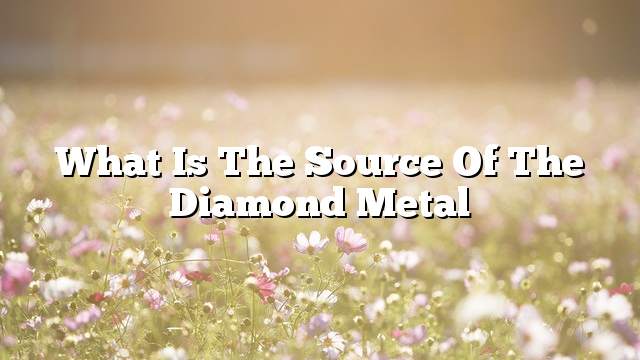Metal Diamond
Diamonds are known as a rare mineral, carbon. The carbon atom surrounds four other carbon atoms connected to strong covalent bonds. Diamonds are considered to be the hardest known natural materials. They are also chemically resistant, have excellent thermal conductivity and are characterized by special optical properties such as refractive index height , High dispersion, and high luster, these unique properties have made this the most precious gemstone in the world, and in this article is talking about the expansion of this metal and its source.
Sources of diamond minerals
Many people believe that the source of diamonds is coal, but this information is wrong; there is no role for coal in forming diamonds, as most of the diamonds dated are older than the first terrestrial plants that are considered as a coal exporter. The real sources of natural diamonds are four Can be summarized as follows:
Deep volcanic eruptions
Geologists believe that diamonds are formed in the mantle layer under very high temperatures and pressures and are transported to the surface of the earth by deep volcanic eruptions that leave behind pipes called kimberlite and lumberwit, which are searched for by diamond explorers. In these blasts the molten magma travels quickly from the depths of the mantle In the area of diamond stability where diamonds and stones are pulled with great speed to the surface, these stones are called (xenoliths) and may be loaded with diamonds.
Ocean sediments
The small diamonds were found in the rocks that were raised to the mantle layer and formed the so-called subtraction range due to tectonic plate movements, where one of the adjacent plates slips into the mantle layer, and as it falls down it will be increased by pressure and temperature. Very rare, if any, it is not suitable for commercial use.
Collision of asteroids
The diamonds are found in and around the nozzles and holes caused by the collision of asteroids on the Earth’s surface, producing tremendous strength, pressure and extremely high temperatures when collisions. These conditions are sufficient to form diamonds, especially if the target rocks contain carbon. For example, Pitbigai pit in northern Siberia, Russia, in addition to finding a small diamond in Metor Crater in Arizona.
Meteorites
NASA researchers have found large numbers of nanomaterials (in English: Nanodiamonds ). In some meteorites, 3 percent of the carbon in these meteorites is converted to these diamonds. These diamonds are believed to be formed in space during high-speed collisions and other powerful events. These diamonds are very small and are used as precious stones or abrasive materials. For example, Smithsonian researchers found large numbers of small diamonds when they cut a sample of the Allen Hills meteorite.
States that produce diamonds
There are seven countries that have led the world to produce diamonds for more than a decade over time. They produce more than one million carats annually, depending on the quantity of production: Russia, Botswana, Canada, Angola, South Africa, the Democratic Republic of the Congo, A group of other countries produce less than 1 million carats a year and have less control over the market than the previous group, depending on the quantity of production: Australia, Ghana, Guinea, Guyana, Lesotho, Sierra Leone, Togo and Zimbabwe.
Quality diamond stone
The Gemstone Institute of America has developed a standard method for assessing the quality of a diamond, known as the 4Cs of Diamond Quality. The 4Cs return to the following factors: color, cut, clarity, And Carat Weight, where the quality and quality of a diamond stone is determined by these four factors:
- the color: High-quality diamonds vary in color from yellow to colorless, but colorless diamonds are the most valuable and the most expensive. There is also a class of increasingly popular diamonds, colored in red, pink, yellow, purple, blue, green, and brown , And the value of these stones is determined based on the intensity of color and purity and quality.
- Clarity: The ideal diamond is free from fractures, impurities and exotic particles; it reduces the appearance of stone, as well as interfering with the crossing of light through stone, and when found in large quantities, dark colors, places or clear sizes, will reduce the quality of the stone and reduce its value in addition to reducing Of the strength of the stone itself.
- Cutting: What determines the appearance of diamonds is the craftsmanship used in cutting diamonds in addition to the quality of design, and the cutting angles and design ratios and polishing quality determines the appearance and brilliance and sparkle and light from it, the ideal diamond stone is well polished, in addition to the size of the faces, The edges of each face match exactly the edges of the adjacent faces.
- Carat: Diamonds are usually sold in 1 carat, or 1.142 ounces carats. The smaller the size of diamonds, the smaller the stones are, and the larger stones are very rare.
Other uses of diamonds
The use of diamonds is not limited to jewelry and jewelry only, but has other uses will be identified as follows:
- It is used as an abrasive material, due to the harsh diamond toughness.
- The domes manufacture high-quality loudspeakers, helping to enhance their performance due to diamond hardness, where the diamond improves the process of vibration.
- Windows made of thin diamond films, used to cover lasers, x-ray machines, and discharge rooms. These windows are transparent, durable, heat resistant and corrosion resistant.
- The manufacture of thermal dispersants, which absorb or transport excess heat, diamonds have a very high thermal conductivity of any material, and is used to heat the heat away from the parts of high – performance electronics sensitive to heat.
- Very small bearing or roller industry, used in small mechanical devices, diamond is highly corrosion resistant and long lasting.
- Manufacture of wear-resistant parts by coating the surfaces with a very thin layer of diamond, which is converted to vapor adhering to the surface to protect it from wear.
